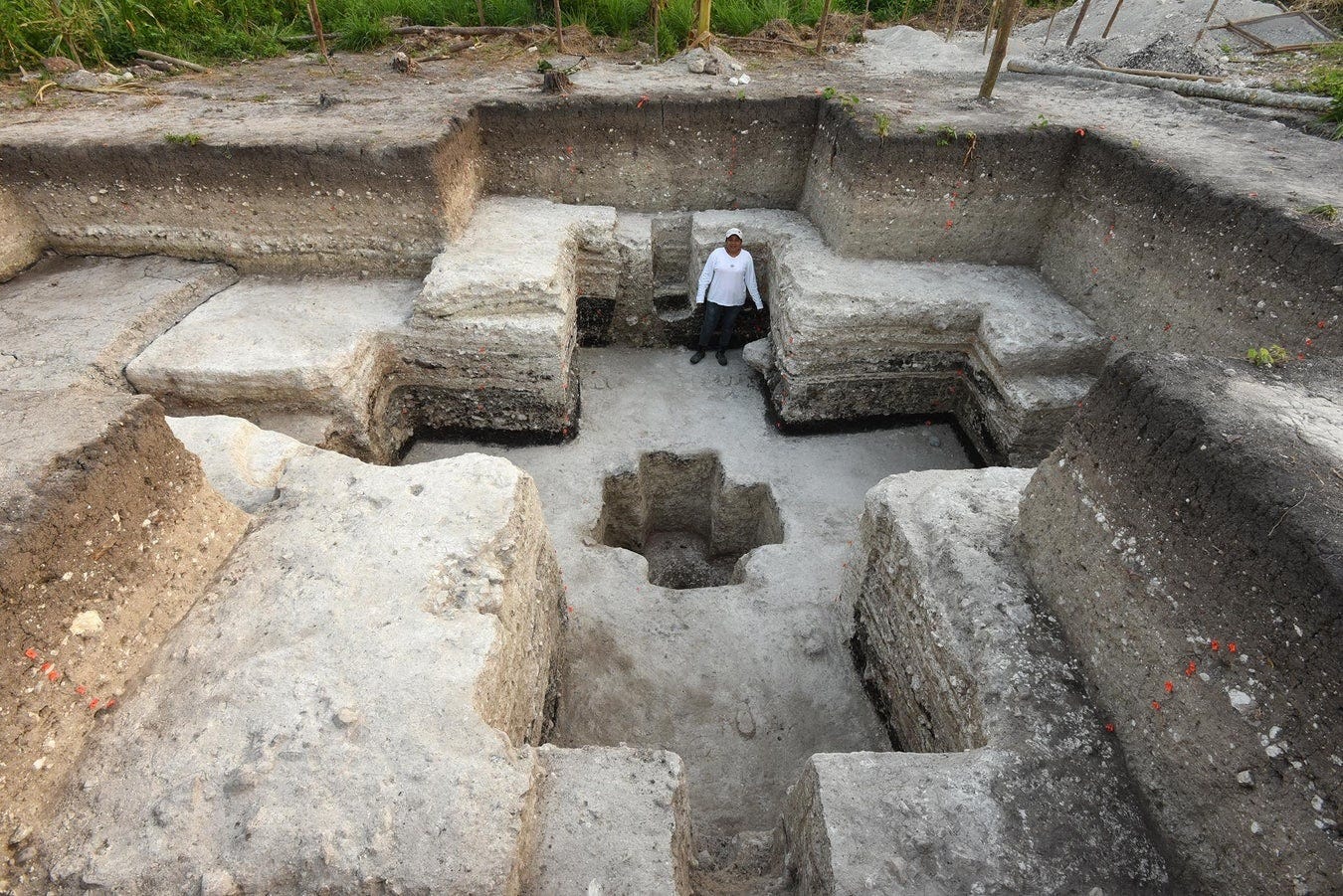🧐 Ancient Beat #173: Cosmograms, pyramid anomalies, and the "Band of Holes"
Hi folks! This is issue #173 of Ancient Beat — here’s the latest ancient news. 👇
🗞 Ancient News: Top 5
Archaeologists Uncover a Monumental Ancient Maya Map of the Cosmos — At the site of Aguada Fénix in the Gulf lowlands of Mexico (Tabasco), dated to around 1050 BCE and built by early Maya groups, a cross-shaped pit carved into bedrock and surrounded by canals and color-coded pigments has been interpreted as a cosmogram—a “map” of the universe reflecting ritual and communal organization rather than elite dominance. The design uses blue azurite, green malachite, yellow ochre and seashells placed in cardinal-direction alignments, and stretches across multiple hectares. The discovery challenges prevailing narratives of early Maya state formation by showing large-scale monumentality built before strict rulership, possibly via collective effort, and invites fresh thinking on how cosmology, community and landscape were integrated.
Archaeologists May Have Finally Solved Peru’s Strange “Band of Holes” Mystery — In the Pisco Valley of southern Peru lies Monte Sierpe, a formation of about 5,200 circular pits nearly a mile long, each roughly 3–6 ft wide (1–2 m) and 1.6–3.3 ft deep (0.5–1 m), that have puzzling origins. New drone imagery and micro-botanical soil samples show traces of maize and reed basket-weaving material in the holes, pointing to a pre-Inca marketplace where goods were exchanged. Later under the Inca Empire, the layout appears to have been repurposed into a large-scale accounting system of tribute and resource management. The dual agricultural and administrative functions of this landscape technology broaden our sense of Andean socio-economic innovation.
Air-Filled Anomalies in Menkaure Pyramid Could Indicate a New Entrance — Two air-filled voids have been detected behind the eastern granite facade of the Pyramid of Menkaure on the Giza Plateau in Egypt. Using non-destructive methods (ground-penetrating radar, ultrasound, electrical resistivity tomography), the voids were located at depths of ~1.13 m and ~1.40 m behind the outer face, with sizes approximately 1 m × 1.5 m and 0.9 m × 0.7 m. The polished granite area (around 4 m × 6 m) that covers them is otherwise similar only to the northern entrance of the pyramid, suggesting this may represent a previously unknown entry or chamber. If confirmed, this would revise our understanding of how the structure was constructed and accessed.
2.75-Million-Year-Old Stone Tools Show Hominin Response to a Hostile Climate — At the Turkana Basin in Kenya, three sedimentary layers dated to ~2.75 million, ~2.60 million, and ~2.44 million years ago preserve stone tools that show remarkable continuity of manufacture over ~300,000 years despite dramatic environmental shifts. The lithic assemblage, part of the earliest known Oldowan industry at the site, was recovered in settings ranging from floodplains to arid riverine landscapes. Their consistent shape and form suggest that early tool-users maintained a stable technological tradition even as climate, landscape and resources changed. The findings highlight early hominin resilience, long-term behavioral stability and perhaps social transmission mechanisms far earlier than often assumed.
Roman Road Network Was Twice as Large as Previously Thought, New Mapping Project Finds — A new digital atlas named Itiner‑e, compiled using historical records, topographic maps, aerial / satellite imagery and archaeological data, shows that the road network of the Roman Empire around 150 CE included roughly 300,000 km (≈186,000 miles) of roads — nearly double prior estimates of ~188,000 km. The dataset spans Europe, North Africa and the Near East and includes both major highways and many previously overlooked secondary rural routes. Importantly, only about 2.7 % of these routes are located with high confidence; the rest are conjectural or based on indirect evidence such as bridge remains or ancient milestones. The expanded network suggests that mobility, administration, trade, and even the spread of disease across the empire may have been far more dynamic than traditionally assumed.
That’s it for the free Top 5! If you’re a free subscriber, sign up for the paid plan for another 28 discoveries and 4 recommended pieces of content covering rats, snack bars, and seal-skin books.
Until next time, thanks for joining me!
-James
Twitter: @jamesofthedrum
P.S. Here’s my Buy Me A Coffee link if you’d like to support my efforts with a donation.
P.P.S. If you want access to the paid version but it’s a little too steep for you right now, just email me — I want this to be accessible.
P.P.P.S. Paid members, read on!
🗞 Ancient News: Deep Dive
Keep reading with a 7-day free trial
Subscribe to Ancient Beat to keep reading this post and get 7 days of free access to the full post archives.


